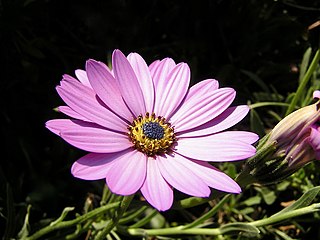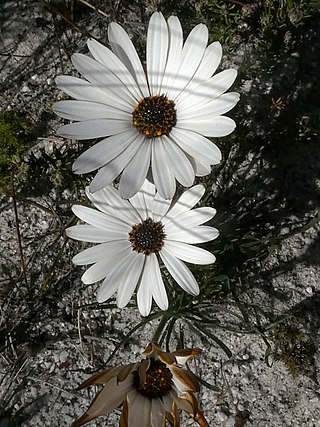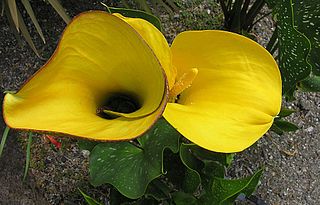
Dimorphotheca pluvialis, common names white African daisy, Cape marigold, weather prophet, Cape rain-daisy, ox-eye daisy, Cape daisy or rain daisy, is a plant species native to South Africa and Namibia. It is sparingly naturalized in scattered locations in California.

Dimorphotheca barberae is a species of flowering plant in the family Asteraceae. The species is endemic to the Eastern Cape in South Africa.

Dimorphotheca caulescens is a species of flowering plant in the family Asteraceae. The species is endemic to the Eastern Cape, Western Cape and the Free State.

Dimorphotheca chrysanthemifolia is a plant belonging to the genus Dimorphotheca. The species is endemic to the Western Cape.

Dimorphotheca montana is a plant belonging to the genus Dimorphotheca. The species is endemic to the Western Cape.

Dimorphotheca nudicaulis is a plant that belongs to the genus Dimorphotheca. The species is endemic to the Northern Cape and the Western Cape.
Berzelia cordifolia is a shrub that belongs to the Bruniaceae family. The species is endemic to the Western Cape and is part of the fynbos. The plant occurs from the Potberg in the De Hoop nature reserve to the Breede River estuary at Infanta. It has an area of occurrence of 150 km2 and there are eight subpopulations. The species is threatened by invasive plants and coastal development.
Erica amoena is a plant that belongs to the genus Erica and forms part of the fynbos. The plant is endemic to the Western Cape and occurs, among other things, in the Table Mountain National Park. The plant is considered rare.

Watsonia tabularis, the Table Mountain watsonia is a plant that belongs to the genus Watsonia and forms part of the fynbos. The plant is endemic to the Western Cape.
Dimorphotheca polyptera is a plant belonging to the genus Dimorphotheca. The species is native to the Northern Cape, Western Cape and Namibia.

Zantedeschia jucunda, the Highveld golden arum, is a perennial, flowering plant and geophyte that is part of the Araceae family. The species is endemic to Limpopo and occurs on the summit of the Leoloberge. The plant has an area of occurrence of less than 380 km2. The plant is threatened by illegal collection by humans as well as mining and human activities.

Dimorphotheca tragus is a plant that belongs to the genus Dimorphotheca. The species is endemic to the Northern Cape and the Western Cape.

Dimorphotheca venusta is a plant belonging to the genus Dimorphotheca. The species is endemic to the Western Cape and occurs in the Wemmershoek, Du Toitskloof and Hexrivier mountains at altitudes of 600 - 1,800 m. The plant is considered rare. The species was described by Nils Tycho Norlindh in 1980.
Berzelia ecklonii is a shrub that belongs to the Bruniaceae family. The species is endemic to the Western Cape and is part of the fynbos. The plant occurs in the mountains between Grabouw and Pringle Bay. It has an area of occurrence of 272 km2 and the plant is considered rare.

Berzelia intermedia is a shrub that belongs to the Bruniaceae family. The species is endemic to the Western Cape and is part of the fynbos. The plant is also known as knopbos, buttonbos, and kolkolbos.

Berzelia rubra is a shrub that belongs to the family Bruniaceae. The species is endemic to the Western Cape and is part of the fynbos. The plant occurs in the Kleinrivier Mountains and has an area of occurrence of less than 10 km2. The plant is threatened by the invasive plants such as Pinus and Hakea species.
Dimorphotheca walliana is a plant belonging to the genus Dimorphotheca. The species is endemic to the Western Cape and occurs at Gordon's Bay at the foot of the Hottentots Holland Mountains. It has an area of occurrence of only 20 km² and there are two subpopulations that are part of the fynbos. The species is threatened by coastal development.

Haemanthus humilis is a perennial flowering plant and geophyte belonging to the genus Haemanthus. The species is native to South Africa, it occurs in every province, as well as Botswana and Lesotho.

Haemanthus montanus is a perennial flowering plant and geophyte belonging to the genus Haemanthus. The species are native to Gauteng, KwaZulu-Natal, Mpumalanga, North West, Eastern Cape and the Free State as well as Botswana.

Haemanthus nortieri is a perennial flowering plant and geophyte belonging to the genus Haemanthus. The species are endemic to the Western Cape and occur on the Nardouwberg. The plant has an area of occurrence smaller than 100 km² and there are three subpopulations. It is threatened by overgrazing and trampling by livestock, road construction, invasive plants and illegal collection by horticulturists.















